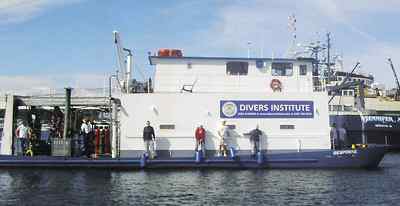 The Institute's well equipped dive vessel Response. On a recent trip to North America, UCI's Michael Cocks paid a return visit to Seattle's Divers Institute of Technology and attended this year's annual meeting of the International Diving Schools Association in Toronto. I was very impressed by the changes that the Divers Institute of Technology (DIT) has made since my last visit there, which was just under three years ago. The school's aim is to provide all air diving and specialist training, including inspection, welding and diver medic courses. The friendly atmosphere at the school was exemplified by the welcome given at the front desk by the cheerful receptionist Shyla Martinez. DIT is currently training over 240 students a year and its main course still lasts for 31 weeks. Under American rules, the school has had to find work for over 70 per cent of students. Currently 93 per cent of its students walk into jobs at the end of their course and, while I was there, one Gulf of Mexico company rang up asking to take the entire student body of the next course. First The school has become the first American school to be able to issue HSE approved diving certificates, albeit under the Canadian umbrella. Diving schools in America, because they are mostly controlled on a State basis, cannot get UK HSE approval for their certificates. DIT has had too spend a great deal of time and money getting approval by the Diver Certification Board of Canada to overcome this problem. Canada checks out all the diving schools it recognises very thoroughly though, so students of DIT can rest assured it meets very high standards. On my previous visit I was impressed by the calibre of the school's instructors. Under the school's director John Paul Johnson, there is now a new director of training, ex-navy master diver Frank LaQue. The team of instructors has been reinforced by a number of younger men, but the average length of diving experience still totals well over 20 years. Shortly, I was told, the instructors are due to go on a brief course to enhance their teaching skills. Much of the day-to-day diving decisions are left to the students who, after four weeks, elect one of their number as a class president. The class president can be changed at any time but, in the three classes I dived with, the students had clearly made a wise choice as no change had been made. All the most modern dive equipment is provided and the school's dive vessel, the Response, is better-equipped than ever and has a very effective hot water system for deep dives. During my visit I was shown a huge pipe-work structure, constructed by Mike Bouchard, which will soon be placed underwater for inspection practical instruction.
I was surprised to find that up to half of the students had not dived before the course, but would-be students are given a very thorough briefing by Nancy Laetsch and Jackie Rule before they are allowed to enrol on the course. They are helped to obtain financial assistance with the course and, unlike some schools, are welcomed back - they can, for instance, do a refresher course in cutting at any time and only have to pay for the cost of the rods. When talking to the students (10 of which were women), I heard no complaints about conditions. The teams seemed, on the whole, to work well together and the tasks they were set were much more severe than I was given when I did my Part One training at Fort William over ten years ago. If students leave their course they are given a fixed proportion of their fees back.
Since Bruce Banks, a former head of US Naval Diver Training, took the school over six years ago, considerable sums have been spent on upgrading the school and appointing new instructors. Bruce spends most of his time on America's East Coast, where his other company is currently engaged in putting back into the sea off Rhode Island and Massachusetts well over 10 million lobsters following an oil spillage. I was pleased that he was able to take time off to be with me in Seattle. The advantage of a school being owned and run by a former or current commercial diver is that such a person will have a far greater knowledge of what makes a good diver and the type of training and help he or she will need. Although more classroom work was taking place at the school than on my last visit, I still managed four dives with three different teams. My first dive consisted of my umbilical being changed out underwater by a student while I got my air through the pneumo - a good way to build up a diver's confidence in his equipment. I undertook two tasks working on a flange; the second structure was mid-water and much more complicated to take to bits than any I had worked on before. However, the highlight of my visit was my first mixed gas dive off the Response. I know my voice sounds odd to most Americans at the best of times, but the addition of helium to it had all the students and instructors rolling around the deck as I tried to communicate. I was able to leave the platform and explore the seabed of Lake Washington at a depth of 85 feet. Celebrating From Seattle, I travelled straight to Toronto for the International Diving Schools Association's 21st annual meeting where the Association was celebrating its coming of age in style. Members came from as far a field as Korea and South Africa and in all there were 35 delegates, including two from the Nautilus Dive Company of Austria whose school has recently been audited ahead of it applying for full membership. The IDSA now has 34 full and associate members and these include schools from Iran, Bulgaria and Brazil. The Association has really sprung to life in the last five years. From Britain, I was pleased to be joined by Mike Pett (who was representing DDRC Pro-Dive Services Ltd, TWI North and Hydroweld) and David Keats of Speciality Welds Ltd. I was disappointed to see that the UK's HSE, IMCA and the American Association of Diving Contractors (ACDI) were not represented this year. Jim Wilson was there to represent the Canadian contractors and Braam van den Berg of Netherlands-based Smit Terminals, who takes a keen interest in the training of his commercial divers, was also present. The meeting's agenda covered a wide range of subjects and final touches were made to the guidelines on training of commercial divers. In future, not only will new schools be fully audited before being admitted to full membership but, over the next few years, all existing members will be audited periodically to see if they are maintaining their standards. Attractive Delegates were shown around the superb facilities for commercial diving training at Seneca College and on the last evening we had a pleasant dinner in the extremely attractive Eaton Hall. We also visited the equally impressive Defence and Civil Institute of Environmental Medicine (DCIEM) and the Canadian Experimental Diving Unit - unlike the British Royal Navy, Canada still does pioneering work in deep diving and divers come from all over the world to partake in these tests. One of the more important subjects under discussion was the certification of divers. David Parkes of the Diver Certification Board of Canada told delegates how the Board's scheme, which began earlier this year, was proceeding. It has taken time to get all of the 13 Canadian provinces to reach agreement. So far 13l certificates have been issued and, for established divers, they last for five years and cost between CA$200 and CA$600, depending on experience (www divercertification.com). We also heard from Jan Merta, the chief inspector of offshore diving in Canada. 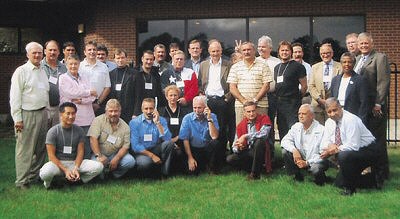 Delegates at the 21st annual meeting of the International Diving Schools Association in Toronto. The IDSA now has 34 full and associate members, and delegates came from as far a field as Korea, South Africa, Iran, Bulgaria and Brazil. IDSA chairman Sijtsche Zwiers, in her role as director of the Dutch certifying authority for diving and diving related certificates, said that, due to stricter legislation in the Netherlands, all divers who work in the Netherlands must now hold a Dutch recognised certificate. She confirmed that when assessing foreign certificates, divers trained at an IDSA full members school will have an advantage over divers trained at schools that are not committed to the IDSA standards. The arrangements for the conference were handled in their usual highly efficient way by Alan Bax and Jill Williams. The social side of such an event is equally important, as it enables delegates to renew friendships and to find out more about training in other countries. It was pleasing to hear that most of the delegates regularly subscribe to UCI and I hope they will use the magazine as one way of communicating with their students and the wider world. The IDSA's next annual meeting will be held 27-29 September 2004 at HydroLAB-HydroCAT in Milan, Italy. I am sure it will be even better attended and will build on the excellent work done in Toronto. . Details: Divers Institute of Technology, 4315 11th Avenue, NW, PO Box 70667, Seattle, Washington, USA, Tel: 1 (800) 634-8377, Website: www.diversinstitute.com; Alan Bax, International Diving Schools Association, 47 Faubourg de la Madeleine, 56140 Malestroit, Brittany France, Website: www.idsa worldwide.org |
© 2003 Underwater World Publications Ltd.
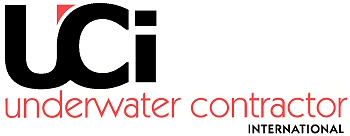
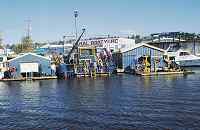 Diving stations at DIT.
Diving stations at DIT. 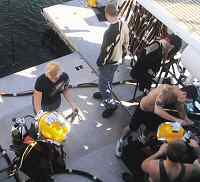 Divers Intstitute of Technology students get kitted up. The school is currently training more than 240 students per year, 93 per cent of which find employment at the end of their course.
Divers Intstitute of Technology students get kitted up. The school is currently training more than 240 students per year, 93 per cent of which find employment at the end of their course.